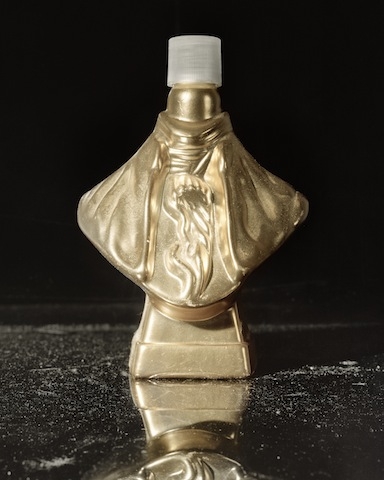Foxy Production, New York, 7 April–14 May
“Every political gesture associated with democracy is branded with a colour,” a voice-over states in Sara Cwynar’s eight-minute film Rose Gold (all works 2017), the centrepiece of this solo exhibition bearing the same title. So what are the politics of rose-gold? Named one of Pantone’s 2016 Colors of the Year (the colour giant identified it as ‘Rose Quartz’), the blush-tinted pink can be found on everything from iPhones and jewellery to men’s sneakers. It’s aspirational, but the soft aspiration associated with minimalism and Scandinavian fashion. (The all-gender Swedish clothing line Acne Studios hopped on the trend early, debuting a pink shopping bag in 2007.) A recent article on New York magazine’s fashion blog The Cut, ‘Why Millennial Pink Refuses to Go Away’, argues that the hue not only complements many skin tones but embodies the gender fluidity of fourth-wave feminism. Paler than the pink on the ‘pussy hats’ worn during January’s Women’s Marches, but more visceral than a neutral nude, this colour is associated with an appealing androgyny.
For all its wearability, rose-gold can be seen as a more politically correct version of the white-skewing ‘flesh tones’ that were prominent on catwalks several seasons ago
Cwynar’s impressionistic film, peppered with quote fragments from thinkers like Lauren Berlant, Toni Morrison and Ludwig Wittgenstein, traces the rise of rose-gold alongside cultural phenomena such as 1970s melamine crockery and the development of swipe technology. It teases us with political messages, spoken against a flow of pleasing, rainbow-coloured images. A male voice intones, “The gold iPhone was invented for China, where gold still means something”, as the view of a Trump hotel flashes by. Rose Gold also ventures into identity politics, troubling the colour’s reputation as “universally flattering” with a montage of ads for vintage makeup compacts. These include the shade Rachel (a creamy hue created during the late nineteenth century, primarily for stage makeup, and based on the skin tone of Jewish French actress Rachel Félix) and Dark Rachel (for a browner complexion). The Rachel colour was originally devised as an alternative for (white) women who would not be flattered by a pink or ivory powder. For all its wearability, rose-gold can be seen as a more politically correct version of the white-skewing ‘flesh tones’ that were prominent on catwalks several seasons ago.
In addition to the video, a series of digitally manipulated photos titled Tracy gesture towards Cwynar’s past as a graphic designer. Six are based on studio portraits of ‘Tracy’, a chic woman of Asian descent. Tracy lounges against backdrops of green or blue (standard chroma-key colours) or a full colour chart. Tracy’s images recall the ‘China Girls’ – usually of white ancestry – whose likenesses appeared in mid-twentieth-century film leaders as a means to check colour calibrations. Cwynar digitally layers four of Tracy’s portraits with fragments from grammar books, art postcards, perfume bottles and anonymous portraits.
In two final series, both confronting myths of masculinity, Cwynar shifts her attention from rose-gold to heavier metals. On two black-and-white photos of medieval suits of armour, printed lifesize, Cwynar has added collage elements of handheld objects, from hairbrushes to obsolescent iPods. The message is a less caustic – more millennial? – version of one that Barbara Kruger put forward in her 1981 photomontage of a groom being manhandled by his best men, accompanied by the line: ‘You construct intricate rituals which allow you to touch the skin of other men’.
Cwynar’s Avon Presidential Bust series conveys a more potent critique. These photographs depict headless, gold-painted bases of Avon aftershave bottles, released on the occasion of the US Bicentennial, in 1976. Only Cwynar’s titles (eg Avon Presidential Bust [Lincoln, Gold]) reveal that the bottles were designed as portraits of the country’s best-known leaders. In lieu of their recognisable visages, the bottles sport only humble perfume nozzles sitting atop cheesy lopsided presidential ascots or bowties. In their mixture of fake opulence and crass commercialism, these yellow-gold objects signify a very contemporary shift in the cultural (and political) temperature.
From the Summer 2017 issue of ArtReview
